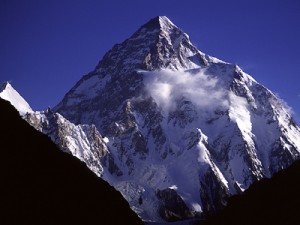Almost constant companions during our trip to Nepal were the Himalayas themselves. In Pokara, I was charmed that from almost anywhere in town you were watched over but not a single peak, but a whole range of impressive mountains. The one that captured my imagination from the start was my first actual sighting of Everest with its distinctive black pyramid shaped peak.
Am I tempted to try to climb it? Well I can’t pretend that I didn’t think about it. Briefly. Some of this was brought about by meeting a Nepali girl who has climbed the mountain several times. She is about 80llbs soaking wet so if she can do it I figured I might have a chance. I certainly like the idea of a challenge on such a huge scale, but while fit but relatively inexperienced people have reached the summit in the past, without significant appropriate experience it seems pretty stupid. If anything goes remotely wrong (and when things go wrong in the mountains it happens quickly and tends to be bad) you really want to know what you are doing up there. So realistically I don’t think I’m about to put in years and years of mountaineering training and hardship…oh yes and it costs an absolute fortune. I don’t have $60k+ burning a hole in my bank account right now.
I’ve decided instead to focus on climbing mountains vicariously. Since my return from Nepal I’ve devoured a series of books on the subject – I’ve actually read Jon Krakauer’s “Into Thin Air” twice – a gripping account of the tragic events of the 1996 season, in addition to Anatoli Boukreev’s account of the same events in “The Climb” plus several of Ed Viesturs excellent narratives of his own climbing career.
What I hadn’t realised prior to reading these books is quite how debilitating extreme altitude is. Of course I appreciated that it is harder to function with less oxygen, but what I hadn’t realised is that breathing supplemental oxygen only somewhat mitigates the problem. Modern climbing plans for Everest and other 8,000m peaks tend to involve a series of sorties to increasingly high camps to maximise acclimatisation. These ascents, sometimes including nights spent at high camps are interspersed with descents to basecamp for people to recover. Over around 25 thousand feet is what is called the “Death Zone”. As the body just deteriorates at that altitude or above, the strategy is generally to spend as little time as possible there. It seems that climbers head for the highest camp, rest there until maybe 11pm, then make their summit push from there overnight. Whether or not the summit has been reached by around 1pm or 2pm the following day, climbers often plan to turnaround and head to more hospitable altitudes asap. Just like diving at depth, the hypoxia experienced at altitude impairs a climbers ability to think clearly so decision making isn’t always great. Some of the problems I’ve been reading about are in part due to people just not turning round when they should, leading to running out of air and things just deteriorating from there. As with so many things, it’s never a single factor that causes problems but you just aren’t able to survive long at that altitude. The hypoxia also affects how you feel – I was a bit disappointed that all the climbers I’ve heard/ read about have reported just a feeling of numbness at the top rather than the elation you’d expect. All that effort for numbness. Still, as Ed Viesturs says, getting to the top is only half way…you need to get back down again too.
In any case. It is bloody tough but a lot easier now than it used to be.
Visiting a small museum in the Nepal, I was able to view a series of exhibits about the first attempts* at the summit and the eventual successful Hillary/ Tenzing effort. What makes their achievement all the more impressive is the gear they used – clumpy leather boots that would have been cold when wet, heavy tents and not a scrap of Gore-Tex in sight.
* My favourite account of summit attempts relates to one mad Englishman who planned to crashland a small plane on the lower slopes of the mountain and climb up from there. The idea is totally bonkers and that’s before you hear that he didn’t actually have either flying or climbing experience. Insane and possibly the earliest recorded incidence of what they call ‘summit fever’.
